Book Pairings: Queen Victoria’s Book of Spells and Royal Airs
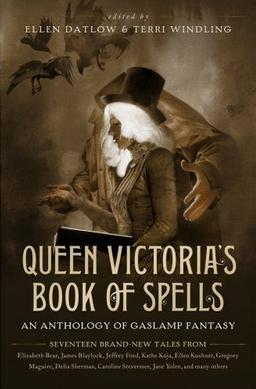 Ah, a rainy night in December.
Ah, a rainy night in December.
I was going to try to augment my blogging-to-raindrops experience by listening to Chopin, but after iTunes had been pianoing at me for a while, I admitted defeat, and realized once more that it’s difficult for me to blog and listen to music at the same time. (Hildegard of Bingen is, of course, an exception to this rule. Sometimes.)
Tonight I am feeling VIRTUOUS and TRIUMPHANT, for I have AT LONG LAST finished Queen Victoria’s Book of Spells, followed by a reread of Sharon Shinn’s Royal Airs. I thought these two books would make a fine complementary pair of Gaslamp Fantasies You Might Like To Read.
Let’s start with Queen Victoria’s Book of Spells.
First of all… It took me LONG ENOUGH! Sigh. Have I told you how long it takes me to read an anthology? Any anthology? I think I did, way back in my Welcome to Bordertown blogging days. But don’t worry if you never read those three monster blogs o’ mine (although you should, because they are CHARMING and INFORMATIVE, and also go ahead and read the anthology itself if you haven’t, because that’s GREAT TOO); like Inigo Montoyo, I will sum up.
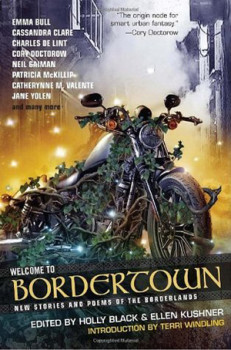 Basically, it’s not that I don’t find anthologies rewarding and delightful. It’s just that… Hopping from one short story to another short story is hard enough when it’s by the same author.
Basically, it’s not that I don’t find anthologies rewarding and delightful. It’s just that… Hopping from one short story to another short story is hard enough when it’s by the same author.
To go from one author to another is so jarring! I think of it as “skull-hopping.” Or… Like being thumped down in an alternate universe, on a planet like but not exactly the same as my own. Same gray matter inventing stuff. Same language expressing stuff. But… alien.
And just when I’m beginning to put down roots into this alienness, and getting into the rhythm of this English language just different enough from the Engish I speak that I have to pay close, close attention, and finding that the air there has begun to to be breathable, then — BOOM! Oh, look! We’re in another universe.
It’s exhausting.
A really good editor (and Datlow and Windling of Queen Victoria’s Book of Spells are among the best) know how to string all these stories, all these disparate alternate universe microcosms, onto a golden thread like so many little rattling skull charms. And in any case, I’m losing my metaphor. If I ever had one to begin with. So I’ll just tell you about a few of my favorites, shall I?
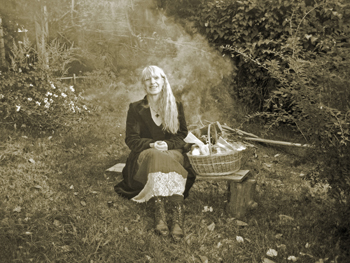
Or perhaps we should begin with a definition of “Gaslamp Fantasy.” According to Terri Windling in the Tor/Forge blog, it is: “a genre of stories set in magical versions of 19th century England.” She goes on to say:
We’ve chosen the term Gaslamp Fantasy for our book rather than the other common appellation, Victorian Fantasy — for in fact these stories can take place at any time during the 1800s, from the Regency years early in the century to Queen Victoria’s long reign (1837-1901). Although commonly set in England itself, Gaslamp tales can also unfold in Britain’s former colonies — anywhere that British culture has been, or remains, a dominant force. Steampunk fiction (which blends 19th century fantasy settings with science fiction elements) is only one form of the diverse range of fiction that makes up the Gaslamp Fantasy genre. There’s also historical fantasy (without Steampunk trappings), dark fantasy with a deliciously gothic bent, romantic tales, detective tales, enchanted tales set in English boarding schools, and Fantasy of Manners: a brand of magical fiction that owes more to Jane Austen, William Thackeray, and Anthony Trollope than to C.S.Lewis and J. R. R. Tolkien.
Well, the book starts right way with my favorite.
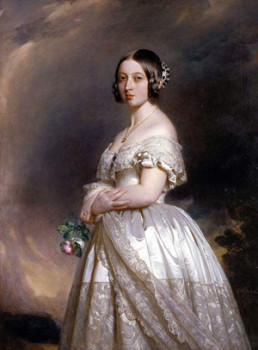
No, I shouldn’t say that. I mean, I should, because I DO MEAN IT, only I had about six favorites. But my first favorite was Delia Sherman’s “Queen Victoria’s Book of Spells.” Part of it is told first person by a graduate student (Subject? Thaumaturgy.) who has a Junior Research Fellowship in the History of Magic. The narrator is basically a code-breaker who specializes in a spell called oratio obscura — text that seems innocuous on the surface, but hides a truer, more dangerous text beneath it. The main text? Princess Victoria’s diaries. And the Princess is not what history makes her out to be. SO FUN!
And before I move on to my next favorite, let me just say right here and now that there wasn’t a single story in this anthology that I didn’t derive some pleasure or delight or gruesome chill from. But lest this blog be as long as the book itself, let me just jump to the ones that ATE MY BRAIN AND HEART. So.
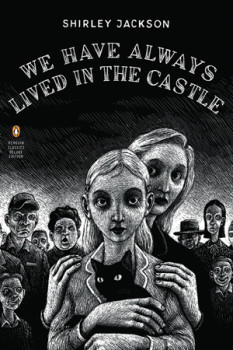 “The Memory Book,” by Maureen McHugh. Okay. I admit it. I love a wicked protagonist. Wicked DELICIOUS. I’m not alone in this, obviously. Why else are “Dexter” and “Hannibal” such huge TV hits? We kind of like watching people chop other people up and occasionally eat them. What I don’t often see is a female in the amoral lead. (Well, let me make a HUGE exception and flag Shirley Jackson’s We Have Always Lived in the Castle.)
“The Memory Book,” by Maureen McHugh. Okay. I admit it. I love a wicked protagonist. Wicked DELICIOUS. I’m not alone in this, obviously. Why else are “Dexter” and “Hannibal” such huge TV hits? We kind of like watching people chop other people up and occasionally eat them. What I don’t often see is a female in the amoral lead. (Well, let me make a HUGE exception and flag Shirley Jackson’s We Have Always Lived in the Castle.)
So this girl, Laura Ann, is a governess. Her family had been well-to-do at one point, isn’t so much anymore. She doesn’t like her downgraded lot in life. Isn’t particularly fond of children either, or the way she’s treated in her position. And when she gets in a temper, you REALLY don’t want to let her near her scrapbook. That’s all I’m saying. Oh, but how MARVELOUS to have a SCRAPBOOK, such an innocent, oft-stereotyped, female-slanted hobby be the instrument of such… Fiendishness.
“La Reine D’Enfer,” by Kathe Koja. And SPEAKING OF FIENDS!!! Okay, okay, this was my FIRST KATHE KOJA, EVERYONE! It’s not like I haven’t been hearing about her for YEARS, and how I should read her, and why. I think I’ve even seen her on panels at conventions over the years. But I’m so glad THIS was my first Kathe Koja. It was… A THEATRE STORY! With SLANG that just begs to be read aloud.
It’s a London peasouper of a tale, all smog and fog and tattered crimson velvet… And the telling of it is so beautifully circular. It’s like a dark falcon released from its jesses to hunt the skies, and it flies wide and high, and comes back with something bloody in its mouth, and stoops right back down to the master falconer, AKA, Kathe Koja. And basically, you should read this one, okay?
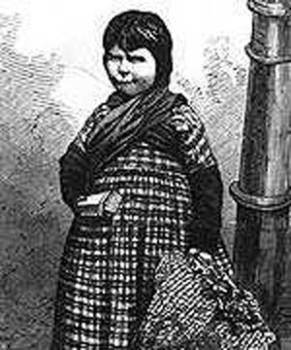
© TUC Library Collections, London Metropolitan University
“Phosphorous,” by Veronica Schanoes. First, I would like to quote my own Facebook status upon finishing this story, and the comments that followed:
Me: “Phosphorus” by Veronica Schanoes accomplished everything I wanted [my first and only Steampunk story] “The Canary of Candletown” to do. But much better. I was pretty much all over in dead chills the whole way through. And even more so reading the author’s afterward. It stated my exact intentions upon writing “Candletown,” with more passionate vehemence than I have ever properly expressed.
“Phosphorus” got me. It got me in the gut, thigh, mind. Most especially in the jaw.
COMMENTS:
Alex Dally Macfarlane: “Phosphorus” was the story in that anthology that really stuck with me. Powerful, painful work.
Caitlyn Paxson: Oh my god, I loved that story! I still think about it.
It was… Basically, it was everything I want in a story, both in the reading and the writing of it. It was intensely researched — specifically, the history of social reform surrounding the exploitation of women workers in match factories, back in the days when the use of poisonous white phosphorous to make Lucifer matches caused the fatal condition known as “phossy jaw.”
It is a piece of hideous history that parallels and illuminates our present. It is also a story full of staunch friends and flawed family and strong ghosts, mythology and nostalgia and triumph. Third person history snippets interrupted with an immediate and painful second person narrative keep either POV from feeling too didactic or manipulative. It clips along, haunting and meticulously structured.
What made the fantasy element work so well was the brutal reality necessitating it. What made the tragedy of the story cathartic instead of the long doomhole into despair it could have been, was the stubborn hope that buoyed even a half-living, mostly dead protagonist to see her own story through to its end.
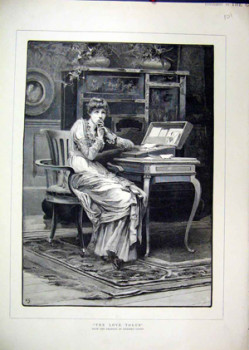 “The Vital Importance of the Superficial,” by Ellen Kushner and Caroline Steverner. AND NOW FOR SOMETHING COMPLETELY DIFFERENT — as the Monty Python boys would say. Ha! Oh, I love, love, love, love, LOVE a good epistolary story! Oh, it makes me want to write ALL the letters to ALL THE CUTE BOYS EVER! (Especially if they’re hot British magicians.) And also to ALL MY BEST GIRLFRIENDS! (Even if they have head colds and get kidnapped by VILLAINS!)
“The Vital Importance of the Superficial,” by Ellen Kushner and Caroline Steverner. AND NOW FOR SOMETHING COMPLETELY DIFFERENT — as the Monty Python boys would say. Ha! Oh, I love, love, love, love, LOVE a good epistolary story! Oh, it makes me want to write ALL the letters to ALL THE CUTE BOYS EVER! (Especially if they’re hot British magicians.) And also to ALL MY BEST GIRLFRIENDS! (Even if they have head colds and get kidnapped by VILLAINS!)
This was such a (yep, I’m gonna use that word, wait for it) ROMP! It was ROMPING GREAT FUN, and it’s one I’ll go back and reread, just so I can read it ALOUD, and giggle. It was sharp and witty and wry and romantic and surprising and just scary enough to make me feel CUDDLY. If you know what I mean.
“Estella Saves the Village,” by Theodora Goss. You know those times when you wish all your favorite characters could just sit down and have tea together, and you could have tea with them, and it would all be BEAUTIFUL? And, yes, I know that there are fan fiction forums for that, but I’ve never sought them out. But still, I’ve dreamed of those tea parties. And who wouldn’t want to go to Sherlock Holmes for advice and cake? Or go play with Mrs. Rochester’s terrier after having tea with the scandalous Lady D’Urberville?
Theodora Goss took this longing that all devoted readers must feel, and then took it a step further. Her protagonist is a re-imagined character from Dickens. One who, I have to admit, I never much liked until I met her in these pages. And now, at the close of the book, I think I’d rather like to be her friend.
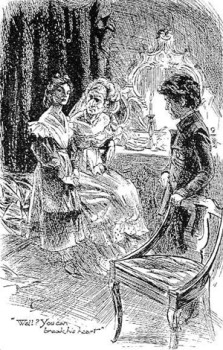
So, that’s about it for this one.
Oh, and P.S., everybody.
Just because these six stories were my favorite THIS TIME, it doesn’t mean a whole DIFFERENT six won’t be my favorite NEXT TIME. I didn’t even talk about the awesome BRONTE story by Catheryne Valente, or Blaylock’s “Smithfield” (with an older Conan Doyle reminsicing about his youthful, pre-Sherlock writer days: “There is a certain wonderful freedom in being young and at the beginning of a literary career, when one’s “fortunes” are small but sometimes glorious…”), or the selkie story comprised in “The Governess,” or Jeffrey Ford’s marvelously creepy, “The Fairy Enterprise.
There are Yolen and Maguire and Valentine and Tanith Lee tales no fans will want to miss. There is also a Pre-Raphaelite story, an hysterical women story, a fraudulent spiritualist story, and a horror story with unstoppable electricity snapping at its core.
So. Read it.
And if you need more Gaslamp Fantasy, allow me to switch gears, and reintroduce Sharon Shinn’s Royal Airs to you.
First of all, it’s a sequel to Troubled Waters.
Ah! But look! I ALREADY REVIEWED both Troubled Waters and Royal Airs here at Black Gate Magazine some years ago, which, if you care to read them, are herein linked for your viewing pleasure.
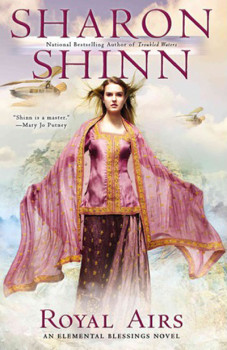 But I wanted to return to the idea of Shinn’s Elemental Blessings series as Gaslamp Fantasy. See, above, Windling defines “Gaslamp Fantasy” very specifically as an Anglocentric genre.
But I wanted to return to the idea of Shinn’s Elemental Blessings series as Gaslamp Fantasy. See, above, Windling defines “Gaslamp Fantasy” very specifically as an Anglocentric genre.
Here in her series however, Sharon Shinn is writing in a secondary world, in her kingdom of Chialto. But the time period runs somewhat parallel to Earth’s late 19th, early 20th century. While Shinn’s world has very a specific and ancient kind of magic, with a strict set of rules to guide it, it also is realizing its own industrial revolution. “Smoker cars” have been invented, and are slowly becoming more common in a previously horse-and-carraige city. Gas lighting is a feature of urban living, though it has not caught on in the rural areas yet.
In Royal Airs, the earliest prototypes for flying machines are just beginning to be tested. One of the characters if very much a The Right Stuff sort of pilot dude. What we have here is a kind of Gaslamp Fantasy with no England anywhere to be seen!
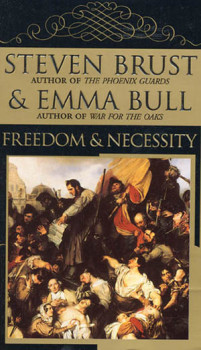 And that, let me tell you, is QUITE refreshing.
And that, let me tell you, is QUITE refreshing.
Also along these lines? Martha Wells’ Death of the Necromancer. Believe me. Slurp. Here again you have Gaslamp Victoriana but no ENGLAND. You have Ile-Rien instead. It’s nice. I like it. ILE-RIEN FOREVER! (Until it falls.)
Oh, and why not, while you’re at it, you might just want to go and read Steven Brust’s and Emma Bull’s Freedom and Necessity. Possibly because it is in my top ten favorite books EVER. Or possibly because reading “The Vital Importance of the Superficial” in Queen Victoria’s Book of Spells will have just put you in an EPISTOLARY NOVEL frame of mind. And possibly just because IT’S AWESOME.
Okay. I’m done.
Have fun. Good reading. Peace out.
 C. S. E. Cooney is a Rhode Island writer and actor. She is the author of The Witch in the Almond Tree, and The Breaker Queen. Her first short fiction collection Bone Swans is forthcoming with Mythic Delirium in 2015.
C. S. E. Cooney is a Rhode Island writer and actor. She is the author of The Witch in the Almond Tree, and The Breaker Queen. Her first short fiction collection Bone Swans is forthcoming with Mythic Delirium in 2015.
She loves to read aloud to anyone who will sit still long enough to listen. Some of her narration work can be found on Podcastle and Tales to Terrify. With her fellow artists in the Banjo Apocalypse Crinoline Troubadours, C. S. E. Cooney appears at conventions and other venues, singing from their growing collection of Distant Star Ballads, dramatizing fiction, and performing such story-poems as “The Sea King’s Second Bride,” for which she won the Rhysling Award in 2011. Cooney will make her debut as an Uncanny Magazine Podcast reader in Episode 3 this January.
Just when I was thinking to myself that I wasn’t a Gaslamp Fantasy kind of reader, you reminded me of Ile-Rien. Yes, ILE-RIEN FOREVER, especially after it falls! The Fall of Ile-Rien novels were my first Martha Wells, after which I rushed to the internet and bought everything she had ever written. I’m saving the Raksura books and Emilie and the Hollow World for a special reading occasion, and I mean saving in the sense that I rushed out in a buying frenzy when each of them came out, and I carefully keep them together in my study, despite my children’s constant efforts to scramble any organization in my library.
Your mention of phossy jaw puts me in mind of Elizabeth Hand’s Mortal Love. Though there are some things in that book that did not hit my personal sweet spot, and several things I’d have done differently if it had been my book, I do think it would make a worthy coda to your pairing. There’s a Supremely Disturbing secondary character with phossy jaw, and she seems quite consciously to be using the effect her face has on others to distract them from even more deeply disturbing things.
SARAH! Sorry it took me a while to respond to this!
Now that we’re talking about Ile-Rien, I just want to reread ALL MARTHA WELLS BOOKS ALL THE TIME! How can you BEAR to save the Raksura books? By not reading them RIGHT NOW you are WASTING all the time in the future you will be spending reading them for the FIRST TIME that you COULD be rereading them for a second or even for a THIRD TIME! (Wow, that was a weird tense. Sheesh.)
I’ve only read the second Emilie book, and I keep meaning to go back and the read the first and third. WHERE HAVE I BEEN? WHY HAVE I NOT BEEN DOING THIS?
I’ve only read one Elizabeth Hand book. The Dionysus one. It was… haunting. Ought I to read Mortal Love? I’m afraid I would be resentful of its beauty. Of the horrible beauty. That’s sort of how the Dionysus one (something about a moon?) made me feel. That there was this aching beauty to be had, but not by me. Not by me.
Sigh. Dreamy.
Maybe I should read it after all.
Mortal Love did have some characters in it who had been in that other book with the moon in the title. I’ve avoided reading that one. A friend who knows me well said, “The whole premise is that everything evil the patriarchy has accused goddess-worshippers of doing is true, so those nasty women must be stopped by virtuous male heroes. Do not read it, Sarah, it can only make you angry.” Since I followed her advice, I’m not able to say how accurate her assessment was of how I would react.
In Mortal Love, there are forms of beauty that are inherently destructive to humans. It’s both fortunate and un- that there are some not-exactly-human characters about.
You have sold me on the necessity of beginning the Raksura books at the soonest reasonable opportunity. And did you see John’s post about the Martha Wells short fiction Kickstarter?
The delicious book I’m longing to reread is Sebastian de Castell’s Traitor’s Blade. You Must Read This Book. It will break your heart so more wonder can fit in it.